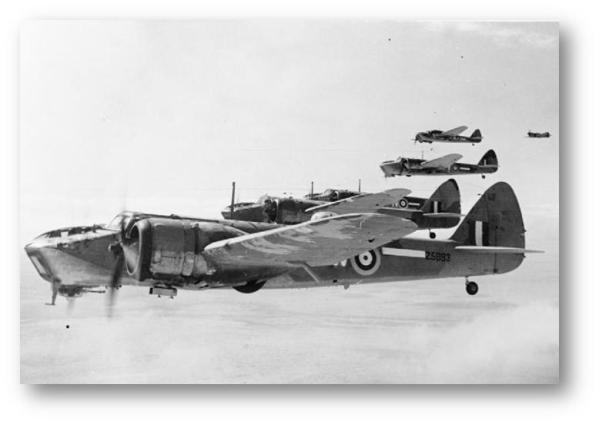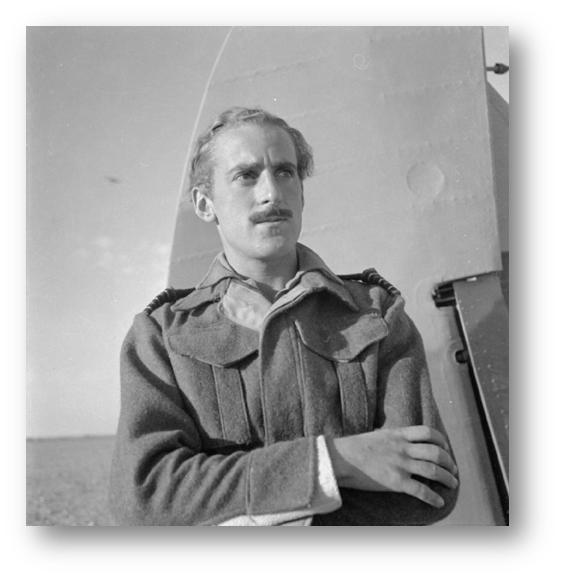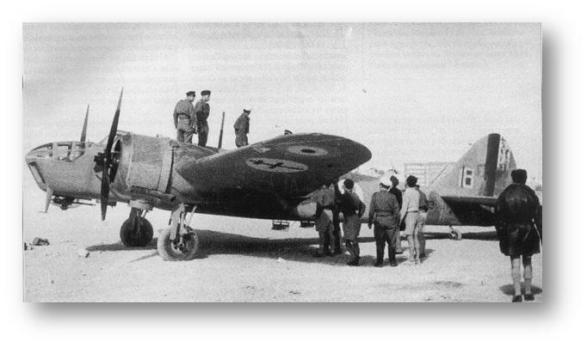Background
In a prior post at this link I analysed the Commonwealth close air support system during CRUSADER, and in another post at this link I wrote about the South African Maryland squadrons active in strike missions for close air support, battlefield interdiction, and attaining air superiority. Reading through the war diary of the D.A.K., I found some notes on the effect of attacks during the battle in the Agedabia position around the turn of the year. These are quoted below. The attacks were carried out by No. 11[1] and No. 14 Squadrons R.A.F. and the Free French Lorraine Squadron (No. 342), all with Blenheim Mk. IV light bombers.

A formation of five Blenheim Mark IVs (Z5893 ‘W’ nearest) of No. 14 Squadron RAF in flight over the Western Desert. A Curtiss Kittyhawk, one of the escorting fighters, can be seen on the far right. This would put the picture into late 1941 or later. Courtesy of the IWM.
Wing Commander Buchanan DFC[2], who led the raid on 31 December, of No. 14 Squadron RAF, shortly after his appointment as Officer Commanding, No. 14 Squadron RAF. From the outbreak of the Second World War, Buchanan flew Vickers Wellingtons with No. 37 Squadron RAF, participating in many of the early bomber operations from the United Kingdom. He was posted to No. 14 Squadron in the Sudan in late 1940, and saw action with them in Eritrea, Egypt and Iraq. After leading the Squadron during Operation CRUSADER in Libya, he was rested before moving to Malta to take command of No. 272 Squadron RAF. Courtesy of the IWM.
The Effectiveness of Raids
One raid is reported by the war diary of Ariete division on 30 December as “light bombardment[3] by enemy air forces, light damage.” It likely this, as well as the D.A.K. entry for 31 December below, refers to the 30 December raid by 11 Squadron, which itself reported no observed hits.
31 Dec 1941
11.30 hrs […] Enemy bomb strike of 9 bombers on [Italian] motorised Corps, accompanied by numerous fighters, passes without losses worth mentioning. German fighters intervene immediately, shooting down 2 enemy planes, AA of 21. Pz.Div. shooting down another one. Attacks with the same strength repeat themselves twice today. Since only HE bombs of smaller weight are dropped, and these without being targeted particularly well, no losses were suffered.
On 31 December however 15.Pz.Div. reports two attacks by 9 planes each, and these were carried out by No. 14 and Lorraine Squadrons, but with 12 planes (6 and 6) in a so-called ‘Buchanan Party’. Again one raid at 1300 with no reported damage, and another at 1430 with ‘only light damage’. The first raid was reported to have caused good damage by No. 14 squadron, with confirmation claimed by photo recce, and 12 vehicles reported to have been hit, very likely an overclaim.
For the second raid the ORB claims results that weren’t as good as the first one. The ORB mentions the dog fight of the top cover with enemy fighters, and the loss of two Hurricanes as a result. One Me 109F is claimed as well. On the other hand, the Germans also overclaimed, since none of the Blenheims appears to have been lost, based on the reporting by No. 14 Squadron. While it is of course possible that the Lorraine Squadron lost a plane, there is no evidence for this. It reports the squadron leader’s plane heavily hit and the raid abandoned, due to a mistake in setting the attack height too low, at only 1,200 feet, exposing the attackers to the full force of light AA. no loss is mentioned in ‘Croix de Lorraine et Croix du Sud’ either, so I don’t think a plane was lost, even though some of the Blenheims were damaged by AA, including one of Lorraine.
Blenheim Mk. IV of Lorraine Squadron, clearly displaying the Cross of Lorraine.
From Ciel de Gloire website.
1 Jan 1942
12.45 hrs bombing attack occurs by 12 Bristol Blenheim on 15. Pz.Div. 1 dead, 1 severely wounded, 6 motor vehicles total loss. 1 enemy bomber shot down by AA.
This far more severe raid again hit Schtz. Rgt. 115¸of 15.Pz.Div., and the division reported 1 KIA and two severely wounded. The loss is given as five trucks and one Kfz.81 [4]. The raid is well covered in the ORB of No.11 Squadron RAF which led it, and shows that at least sometimes there was astonishing accuracy in reporting damage caused.
1st January, 1942
Bombed dispersed M.T. at BELANDAH, pin-point 3005 from 2,000 feet.
All bombs were observed to fall in target area amongst 150 – 200 M.T. well dispersed. Top cover fighter escort reported 5 vehicles left burning and one lorry presumed to contain ammunition explode. This formation operated with aircraft of NO.14 Squadron and the FREE FRENCH LORRAINE SQUADRON. One run was made over target without dropping bombs.[5] The second run was made and the target bombed. The A.A. at this stage was intense and on turning away from the target the formation ran over another bunch of dispersed M.T., aircraft NO. 2226, piloted by P/O FROGGATT[6] was shot down in flames and seen to explode on hitting the ground.
Two other aircraft of No. XI SQUADRON were also hit by A.A. but slight damage resulted and the aircraft returned to base safely.
The A.A. was light and medium calibre very intense and accurate as to height and direction.
Weather:- Fair over target – wispy clouds. Visibility:- Fair.
Bombs dropped:- 20x 250 lbs G.P. fitted with extension rods.
Participating aircraft:
5604(?) S/ldr. Murray, Sgt. Cameron, F/Sgt. Ware, lead aircraft
2226 – see note below
5819 P/O H.T.L. Smith, P/O Sayers, Sgt. Alderton
5586 Sgt. White, Sgt. Stair, Sgt. Watt
7685 Sgt. Payne, Sgt. Burnside, Sgt. Cameron
What is of interest is that this raid was carried out at a considerably lower height, only 2,000 feet, compared to 4,500 feet in the raids on 31 December. W/Cdr Buchanan, according to ‘Croix de Lorraine et Croix du Sud’ chose bombing height such that it was at the edge of prevalent AA range, in this case the light 20mm guns.
Nevertheless, also on 31 December it is noted that the decision by Rommel to retreat from the Agedabia position was due in the first instance to the weakness of the Axis air forces, which had a range problem in covering this position, and the consequent ability of the English (sic!) air force to smash Axis tanks and vehicles at their leisure. One wonders if this is the first instance of Rommel’s fear of the Allied air forces, that was later to play such a prominent role in the German command debate on how to react to the landing there.
Notes
[1] No. 11 Squadron was back in action in Libyan skies during 2011, this time flying Eurofighter Typhoons.
[2] W/Cdr Buchanan DSO, DFC, Croix de Guerre (Belgium) died at sea after his Beaufighter was shot down south of Athens in 1944 and he managed to escape into a dinghy. He was by then CO of No. 227 Squadron operating out of Malta. See this link and this link for some background on this very interesting officer.
[3] spezzonamenti – spezzoni were light (10-20kg) bombs used by Italian planes. It says something not very favourable for the impact of 250lb GP bombs that they were confused with 20-40lb bombs.
[3] Version of standard light Krupp truck. The Kfz.81 was the ammunition carrier version for the 2-cm AA gun. So again a clear confirmation of the claim.
[4] Presumably to ensure that the target was Axis, and not friendly, vehicles.
[5] With P/O Froggatt were Sgt. Prentice as observer and Sgt. Young W/Opw/AG – the whole crew was killed in the crash, and are buried on the CWGC cemetery in Benghazi.
Sources
- National Archives, Kew: AIR27/193 and AIR27/199, ORBs of No. 14 Squadron. AIR27/157, ORB of No. 11 Squadron.
- NARA, College Park, MD: war diaries of Deutsches Afrika Korps and 15.Pz.Div.
- Ferry, Vital ‘Croix de Lorraine et Croix du Sud’.



Hi, thanks for linking to my blog. Buchanan was certainly an interesting character. I wrote a chapter about him in my book ‘Portsmouth’s WW2 Heroes’, but your article has definitely added to my understanding of this part of his career.
LikeLike
James, many thanks for the info about him, it really helped me a lot too.
All the best
Andreas
LikeLike
Just come across this site. Great stuff and very helpful in helping me piece together my father’s (Aubrey Pontet-Piccolomini) time with 272 Sqn (Nov 42 to Dec 43), when Wng Cdr Buchanan was CO. Have you dates of his command of 272, per chance?
LikeLike
Hi Patrick – that would be him I guess?
http://dc390.4shared.com/doc/zB2Ul5Uo/preview.html
I am afraid I have no records for the time you need the info for, all I can recommend is to ask the knowledgeable folks at http://forum.12oclockhigh.net – I presume you dowloaded the Squadron ORB from the TNA website?
All the best
Andreas
LikeLike
Hi Andreas, Have since found details. BUCHANAN commanded 272 from 22 Nov 1942 through to October 1943 when Wng Cdr Wyndham A Wild took over as CO. The 4shared link you provided is data I wrote up on my father. Comes around in circles. lol. Very many thanks for your help.
LikeLike
Hi Patrick
I thought that was yours. 🙂 Good stuff you found it. But you did get the ORBs? They can be dowloaded cheaply (okay, maybe not for 1 year) from TNA if they are available at all.
All the best
Andreas
LikeLike
Hi Andreas. ORBs? If referring to record of service, I have my father’s.
Kind regards,
Patrick
LikeLike
Hi Patrick
I mean the squadron’s Operation Record Book. These have been digitised by the National Archives and can be downloaded for UKP3.5 per section, with sections being of variable length. I have the 272 Squadron ORB for 11/41, and it is very good quality and very detailed.
All the best
Andreas
LikeLike
Hi Andreas. Ah, yes. I have 272 Sqn’s ORB (sorry, slow brain didn’t register at time!) Jan-May 43 courtesy of the nephew of FSgt Duquette, who crashed into the sea 8 May 43 and he and his nav, Sgt Johnson were killed.The nephew has pulled a vast amount together about his uncle and the crash, etc. He and I have shared the many photos of the Squadron’s personnel and some aircraft I have.
Following your advice, I will try to get the remaining ORB’s and if available the Detail of Work Carried Out sheets – the latter is more informative and includes the aircraft numbers and crews.
Kind regards,
Patrick
LikeLike
“spezzonamenti – spezzoni were light (10-20kg) bombs used by Italian planes.”
Actually 10kg were still classified as bombs by Italians, spezzoni were between 1 and 2 kg , with 4kg max with AR-4 “Thermo bomb”, but it think they are maybe meaning an overall widespread bombing.
Below cylinders of spezzioniera in a Caproni. Every cylinder could take several small bombs of 1kg(anti personnel) or 2kg(incendiary):

External Spezzioniera Nardi in a Re2002
http://www.modellismopiu.it/modules/newbb_plus/print.php?forum=102&topic_id=122443
Every major Italian bomber could drop hundreds of spezzoni.
LikeLike
Many thanks Dili!
LikeLike
My pleasure.
LikeLike
Pingback: Pictures of Bristol Blenheim's only - Page 4 - World War 2 Talk
Hi Andreas,
I can’t tell you how excited I am to of come across your write up. I am trying to research my Grandfathers time in the XI Squadron. His name is P/O Sayers, who sadly passed away in May 1990, and a specific search directed me to your site. I have his Observers and Air Gunners Flying Log Book and was able to trace the raid at Adgedbia on the 1st January 1942. Rather than decribe the entry I will simply write it below:
“Z’MSUS – 20MLS S/E AGEDABIA BOMBED FROM 2000′ FROGGIE SHOT DOWN. HOLED IN P.TANK.”
If I can provide any further details for the excellent work you are doing I will be happy to help. I would also be interested in anything more on the XI Squadron.
One thing I note is that you have stated the plane my Grandfather was in was No. 5819, however his logbook suggests V9418.
Regards
Chris.
LikeLike
Hi Chris
I am sending you an email separately.
All the best
Andreas
LikeLike
Pingback: No. 11 Squadron RAF | No. 11 Squadron RAF - Wikipedia - everything is here